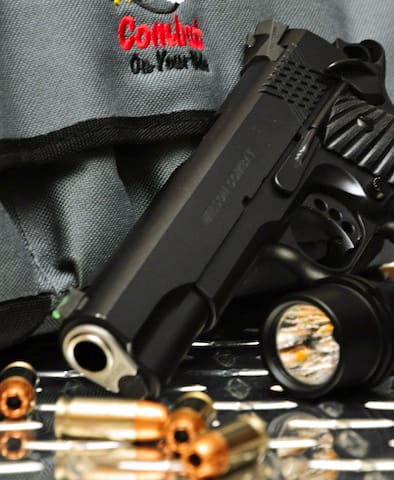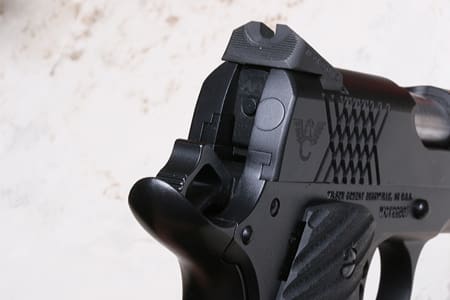
High end luxury cars are still cars. They get you from point A to point B. Unless they don’t. Rolls Royce used to call the problem “failure to proceed.” Never mind. Their owners don’t. They accept a certain level of mechanical “quirkiness” in exchange for beauty and bragging rights. Top end firearms makers don’t have that luxury. They can’t put rarity or comfort ahead of reliability. While you and I might consider a Smith & Wesson 500 a novelty, plenty of owners use—and yes depend on—the weapon. Wilson Combat “gets it.” The legendary gunmaker makes its living by combining battlefield-strength reliability with high end luxury. Call it functional luxury. Or X-TAC.
Design
The X-TAC has a multiple personality disorder—and I mean that in a good way. On one hand, it’s a work of art. The 1911-style pistol’s silky smooth Mil-spec Parkerized finish and uniquely patterned frontstrap and slide treatment are way too sexy for its shirt. The weapon’s classic proportions are exactly as God and John Browning (same thing?) intended. You don’t have to obsess about the X-TAC almost microscopic attention to detail to see that the gun is a thing of beauty. But you can if you want to.On the other hand, the handgun is more than slightly “intimidating.” And again, I mean that in a good way. The Wilson’s big bad beavertail, X-marks-the-spot graphic (on the side of the barrel) and exclusive black-on-black, rope-like G-10 Starburst grip panels create an overall air of malevolence. This doesn’t need to be said, but I’ll say it: if you were looking at this X-TAC from the muzzle-side, that vast, gaping hole in front would make you think twice about doing something aggressive.
Love at First Sight?
The first thing you notice when shooting the X-TAC: the sights. More specifically, the rear sight. Imagine a square crossed with a trapezoid with six-sides. An asymmetrical hexagon if you will. The .145” wide U-Notch is designed for “optimum sighting in low-light, dynamic range conditions.” Most sights—combat or target style—are square shaped with sharp edges, and have an equally square sight notch. Wilson says this new “Battlesight” (combined with their fiber optic front sight) provides a “crisp, protected sight picture.”
Eventually. Initially, the sights don’t naturally “fall” into place like other sets. For proper alignment, you have to align the top of the front sight with the top of the rear sight. Sound simple enough right? Like others fortunate enough to get some hands-on experience the X-TAC, I found myself aligning the fiber-optic tube with the bottom of the rear sights “U”, causing most shots to go low. Of the six people who shot the pistol, five of them grouped low. Only one person naturally found the correct sight picture.
Even after putting 1000 rounds of ammo through the Wilson X-TAC, I still had to pause and think about the sight picture each and every time. Perhaps with another 3000 rounds, aligning the sights will become instinctual. I’d prefer Wilson’s standard sight set or a set of their optional tritium sights. At the bare minimum, a set of fiber-optic fibers in the rear sight would help get the front sight naturally aligned with the rear.
Aw Shoot
Aside from the difficult-to-align sights, in fact even WITH the difficult to align sights, the X-TAC is to shooting what a Rolls Royce Phantom Coupe is the Cote D’Azur: class, style and elegance. The Wilson holds well, points well, shoots well and does everything it is supposed to do with subconscious (for the shooter) ease.
Category ›
WEAPONS
 Unknown
Unknown
 Monday, September 27, 2010
Monday, September 27, 2010










No comments:
Post a Comment